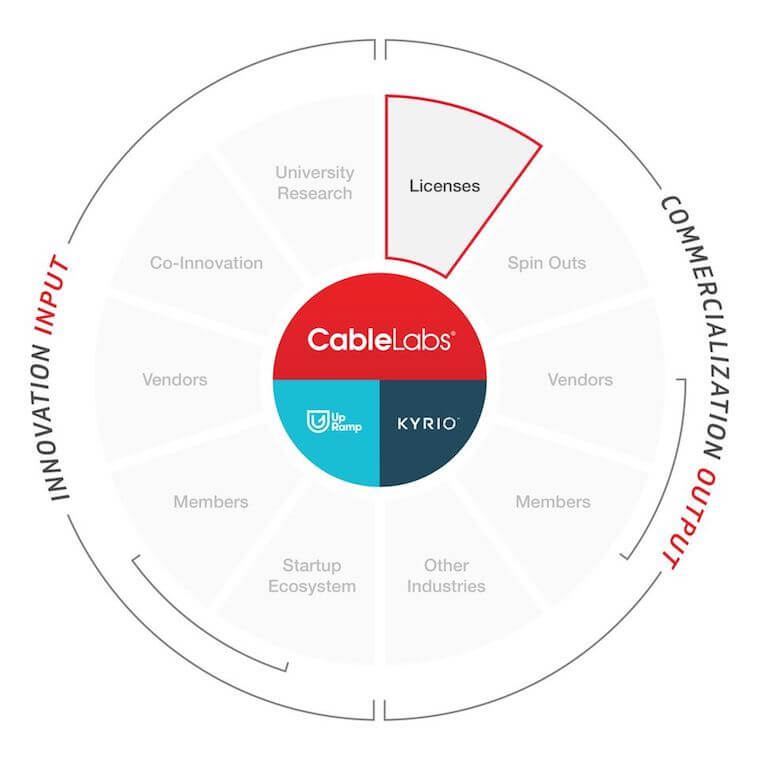Hi, Jud here. A lawyer, writing a blog. Why? Because I’ve been asked so many times about how patents and licensing works that I decided to write it all down as an element in our CableLabs Innovation Series. I tend to spend a lot of my time (understatement!) working on both patents and licensing. So, here it goes.
In this blog, I’ll use the DOCSIS cable modem specification as an example because it’s foundational to broadband — and broadband is life, right? Those of you who’ve been around since the early days of DOCSIS, know that it’s evolved in a lot of different ways. When DOCSIS was developed it was a method for delivering Internet speeds of 37 Mbps downstream (toward homes) and 8 Mbps upstream (toward the Internet.) These days, devices based on the newest DOCSIS flavors can blast data at a rate of 10 Gigabits per second, both ways.
But that didn’t just happen. It took process, development, governance, patents and licenses.
Why are Patents Important?
Patents are actually called out in the original U.S Constitution!
In theory and in practice, a patent protects inventive ideas for a specified and exclusive period of time. In return, the inventor agrees to disclose the invention to the public. Patents advance the general knowledge about the invention to the public. After the period of exclusivity, the public is free to use the invention to advance the technology further. As you can probably imagine, patents abound in complex technology areas such as telecommunications.
Why is Licensing Important?
Almost all standards and specifications carry an associated patent licensing requirement. That is to say, if you agree to work on and contribute to a specification, you also agree to license your patents that are essential to the implementation of that specification. This reality exists to prevent parties from inserting patented technology into a specification, then later say “gotcha!” by alleging the existence of patents that obviate your products, even though they conform to the specification. In legal-speak, this is known as a “patent hold-up.” If you’re thinking “hold up” as in “stick’’em up!” you’re in the zone.
Ideally, for the sake of technological cooperation, interoperability, and advancements in innovation, players in the industry adhere to a patent licensing policy that sets up an environment of “leave your guns at the door.” In essence, manufacturers can then implement the specifications, without the fear of being sued for patent infringement by other DOCSIS manufacturers.
Again, using DOCSIS as an example, this is precisely what its licensing agreement, arranged long ago by CableLabs, provides: all signators agree to license their standard essential patents (SEPs) to CableLabs, including the right for CableLabs to the sublicense the SEPs to all other licensed signators – all on a royalty-free basis.
How Licensing Benefits Innovation
Licensing arrangements also create a nurturing environment for technological development, within which all parties can innovate, because all are free to build on everyone else’s technology — again, without fear of later having to pony up unforeseen patent royalties.
The DOCSIS licensing arrangement fostered by CableLabs in the mid-’90s was and is a significant catalyst in the development, implementation, and widespread adoption of the DOCSIS platform. In all, this gun-free, royalty-free DOCSIS licensing environment consists of more than 200 signators! (In licensing terms, that’s a lot.)
Taking another approach: RAND
Many other typical telecommunications standards (e.g., 3GPP, Wi-Fi and DSL) were generally developed under a “reasonable and non-discriminatory,” or “RAND” patent policy. A RAND patent policy allows participants to collect “reasonable” royalties on patents required to implement the standard.
It follows that manufacturers sometimes sue each other if they disagree on what is “reasonable.” This can add a significant cost, as well as risk and uncertainty, to the development and deployment of these technologies. In case this isn’t patently obvious (see what I did there?), a RAND royalty rate is always greater than a royalty-free royalty rate! (And under the DOCSIS licensing arrangement, the RAND royalty is always $0.)
How Licensing Impacts the Bottom Line
How does this translate to the real-world bottom line? Since its inception, over 2.5 billion DOCSIS-based cable modems and gateways have been deployed. All with no royalties for patents necessary to implement the DOCSIS specification.
As the DOCSIS technology evolved to add additional features, faster speeds, and improved technology, so did the “patent pool” set up by the license arrangement expand. Think about it this way: if there were 1,611 technical requirements in DOCSIS version 1.0, there are 5,758 requirements in DOCSIS 3.1. That’s a pretty big expansion, and a lot of intellectual property, all protected from infringement litigation.
Licensing Arrangement as the Unsung Hero
It’s true that probably only lawyers think licensing is sexy, and that’s ok. But know that even if licensing doesn’t necessarily “wow” you with revolutionary advancements in cable/internet/wireless technology (see our Full Duplex DOCSIS and Coherent Optics technology pages), it’s still an important mechanism for business as usual.
From this lawyer’s perspective, the CableLabs’ royalty-free DOCSIS licensing arrangement has been the unsung hero for the last 20+ years, in terms of fostering implementation and rapid technological innovation, reducing risk, advancing adoption, and expanding deployment worldwide. And, as DOCSIS continues to be the workhorse for all things broadband, it is legally positioned to succeed.
That’s it! Feel free to contact me for more information, and thanks for reading!
